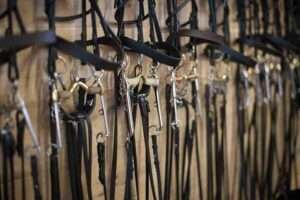A hackamore bridle is a piece of equestrian equipment designed to control a horse without the use of a bit. Unlike traditional bridles that incorporate a bit in the horse’s mouth to control and direct movements, a hackamore relies on pressure points on the horse’s face, nose, and chin for communication and control.
Components of a Hackamore Bridle:
- Noseband: The noseband of a hackamore bridle encircles the horse’s nose and can apply pressure to specific areas, such as the bridge of the nose or the sides.

- Shanks: The shanks are the sidepieces that extend below the horse’s jaw and connect to the reins. When the rider pulls on the reins, pressure is applied to the horse’s nose, and chin, and poll through the shanks.
- Reins: Like a traditional bridle, a hackamore has reins that the rider uses to communicate with the horse. However, instead of connecting to a bit, the reins attach to the shanks of the hackamore.
Functionality of a Hackamore Bridle:
The hackamore works by applying pressure to sensitive areas of the horse’s face, influencing its movements and responses. Different styles of hackamores exert pressure in varying ways. Some hackamores have a mechanical or leverage action, while others use a direct-pressure system.
Common Questions Asked:
Why use a hackamore instead of a bit?
- Bitless Option: The primary advantage of a hackamore bridle is that it provides a bitless alternative for riders who prefer not to use a bit due to concerns about the horse’s comfort or for various training philosophies.
-

Sensitive Horses: Horses with sensitive mouths, dental issues, or those that resist the presence of a bit may respond positively to a hackamore.
- Training Purposes: Hackamores are sometimes used during the early stages of training or with young horses to introduce them to cues without the use of a bit.
- Transition Tool: Riders may use a hackamore as a transitional tool when moving a horse from a bit to a bitless bridle. It allows the horse to adapt gradually to the change in communication.
What does a hackamore bridle do?
A hackamore bridle is an alternative piece of horse riding equipment designed to control a horse without using a bit. Unlike traditional bridles that incorporate a bit in the horse’s mouth, a hackamore relies on pressure points on the horse’s face, nose, and chin for control.
How to Fit a Hackamore Bridle:
- Noseband: Ensure that the noseband sits comfortably on the horse’s nose without being too tight or too loose. It should rest just below the cheekbones.
- Shanks: The shanks should hang vertically, not tilting forward or backward. The length of the shanks can affect the severity of the hackamore, so choose an appropriate length based on the horse’s training level and responsiveness.
- Reins: Attach the reins to the rings on the shanks. Make sure they are even in length, allowing for equal communication on both sides.
- Adjustments: Check for any rubs or discomfort and make adjustments as necessary. The hackamore must sit comfortably on the horse’s face without causing undue pressure.
Are hackamore bridles harsh?
The degree of harshness in a hackamore bridle depends on the design and the rider’s hands. While hackamores are generally considered gentler than bits, misuse or excessive pressure can still cause discomfort. It’s essential for riders to be educated on proper use and have a sensitive feel for their horse’s responses.
Why ride a horse in a hackamore?
- Bit Sensitivity: Horses that are sensitive to bits or have had negative experiences with them may respond better to a hackamore. The absence of a bit can contribute to a more relaxed and cooperative horse.
- Transition from a Bit: Some riders use a hackamore as a transitional tool when moving a horse from a bit to a bitless bridle. It allows the horse to adapt gradually and comfortably to the new form of communication.
- Training and Communication: Riders focused on natural horsemanship or those emphasizing communication through subtle cues may prefer hackamores. They allow for clear communication without the use of a bit, encouraging a more nuanced and responsive relationship between the rider and the horse.
How Does a Hackamore Bridle Work?
A hackamore bridle works by applying pressure to specific areas of a horse’s face, primarily the nose, chin, and sometimes the poll. Unlike a traditional bit that goes into the horse’s mouth, a hackamore relies on external pressure points. When the rider pulls on the reins, the shanks of the hackamore exert pressure on these facial areas, influencing the horse’s movements and responses.
Are Hackamore Bridles the Same as Bitless Bridles?
While hackamores are a type of bitless bridle, not all bitless bridles are hackamores. Bitless bridles, in general, encompass various designs that operate without a bit. The term “bitless bridle” is an umbrella term that includes hackamores, side pull bridles, cross-under bridles, and others. Each type of bitless bridle functions differently and may apply pressure to various parts of the horse’s head for control.
What is a Flower Hackamore?
A flower hackamore is a type of decorative hackamore that includes floral or decorative elements on the noseband. While the primary function remains the same, the flower hackamore adds a touch of aesthetics to the bridle, making it a stylish choice for riders who want a bitless option with a unique design.
Want to buy one Click Here!
Other Types of Bitless Bridles and Their Uses:
- Side Pull Bridle: Similar to a hackamore, a side pull bridle applies pressure to the sides of the horse’s face. It is a simple and direct bitless option.
- Cross-Under Bridle: This design features two straps that cross under the horse’s jaw. When pressure is applied, it creates a gentle squeezing action, influencing the horse to respond.
- Bosal: A traditional bosal is a type of bitless bridle commonly used in Western riding. It consists of a noseband made of rawhide or other materials and is often paired with a mecate rein.
Best Way to Tie the Rope Under the Jaw
The rope or mecate attached to the hackamore can be tied in various ways, such as a simple loop or a fiador knot. The fiador knot is a secure knot that attaches the mecate to the hackamore while allowing for quick release when needed. It’s important to tie the knot snugly but not too tight to avoid discomfort for the horse. Riders should familiarize themselves with the specific knot used and ensure it is tied correctly for safety.
Considerations
While hackamores are generally considered milder than bits, riders must use them correctly and be mindful of the pressure applied. Improper use or excessive pressure can lead to discomfort for the horse. In summary, a hackamore bridle provides a bitless option for controlling and communicating with a horse, making it a suitable choice for riders who prefer alternative methods of control or for horses that may be more comfortable without a bit.
Conclusion
The choice between a hackamore and a bit depends on various factors, including the horse’s preferences, the rider’s skill, and the intended use. While hackamores are generally considered milder, proper education and usage are crucial for ensuring the horse’s comfort and well-being.
Always consider the individual horse’s comfort, the rider’s skill level, and the intended use when selecting and fitting a bitless bridle, including a hackamore. Proper education on bitless options and their correct usage is essential for the well-being of both the horse and rider.






